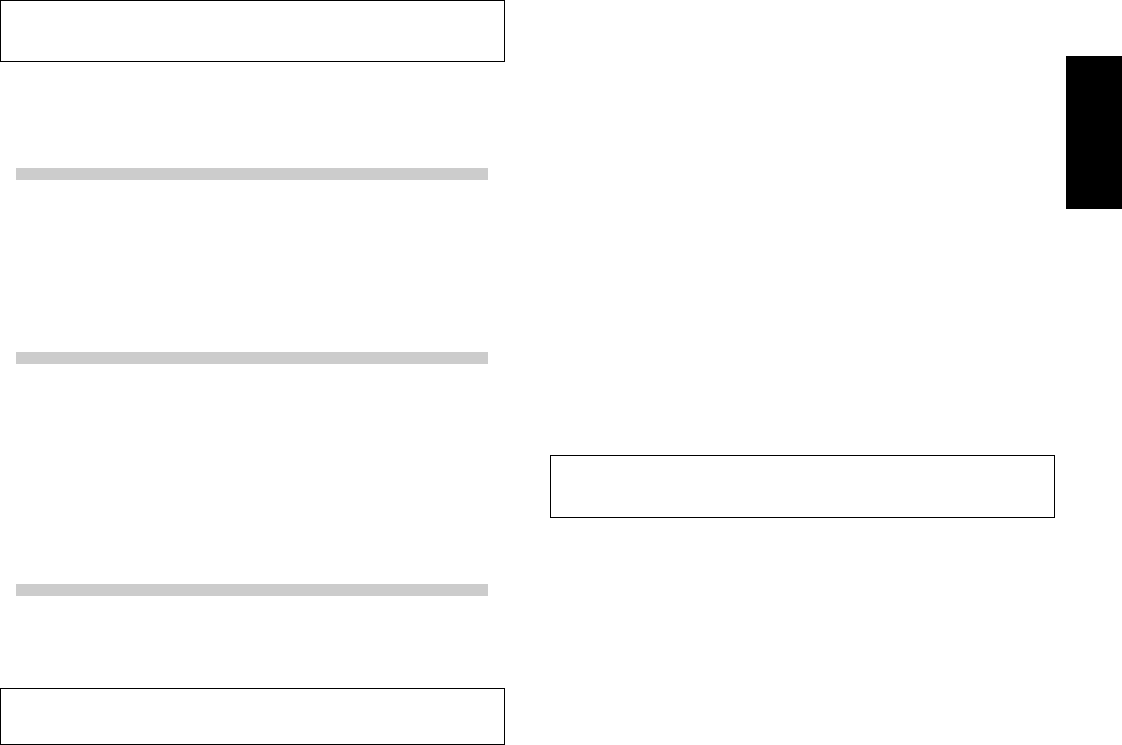
3
<DRB1404>
En
English
CONTENTS
CAUTIONS REGARDING HANDLING ........................ 2
SPECIFICATIONS......................................................... 3
FEATURES ................................................................... 3
BEFORE USING
CONNECTIONS............................................................ 4
CONNECTION PANEL ........................................... 4
CONNECTING INPUTS.......................................... 5
CONNECTING OUTPUTS...................................... 5
CONNECTING THE POWER CORD ...................... 5
NAMES AND FUNCTIONS OF PARTS ...................... 6
OPERATIONS
MIXER OPERATIONS .................................................. 8
BASIC OPERATIONS ............................................. 8
FADER START FUNCTION .................................... 9
EFFECT FUNCTIONS ................................................. 10
TYPES OF BEAT EFFECTS .................................. 10
PRODUCING BEAT EFFECTS.............................. 11
IN-LOOP SAMPLER ............................................. 11
EFFECT PARAMETERS........................................ 12
OTHER
TROUBLESHOOTING ................................................ 13
BLOCK DIAGRAM...................................................... 76
1 Designed for high sound quality
Analog signals are sampled at 96 kHz/24-bit, comparable to
professional performance levels. Mixing is performed with the same
type of 32-bit DSP as used in the DJM-1000 and DJM-800, thus
eliminating any loss in fidelity, and producing clear and powerful
club sound optimally suited for DJ play.
2 3-band equalizer with kill function
Equalizer functions are provided for each of the three bandwidths HI,
MID, and LOW, and a kill function is provided to drop the attenuation
level to –∞.
3 Wide variety of effects
1) Beat effects
The “beat effects” so popular on the DJM-600 have been given
further evolution. Effects can be applied in linkage to the BPM (Beats
Per Minute) count, thus allowing the production of a variety of
sounds. Some of the effects include delay, echo, filter, flanger,
phaser, robot, and roll.
2) Beat select buttons
Automatically set the effect time linked to the BPM. Allows selection
of desired BPM for synchronizing beat effects.
3) IN-LOOP sampler
Detects the current track’s BPM and records up to 5 of 4-beat sources
in banks, and plays a loop in time with the track’s BPM.
4 2 MIC input, AUX switching
Equipped with 2 MIC input jacks that can be switched to AUX,
allowing use as a third LINE input.
5 Auto talk-over
The auto talk-over function automatically reduces track volume when
microphone input is detected.
6 Other functions
¶ A control cable can be used to connect the unit to a Pioneer DJ CD
player, thus allowing playback to be linked to operation of the
fader (“fader start play”).
¶ “Fader curve adjustment” function allows modification of the
cross fader curves.
¶ “Auto BPM counter” provides visual representation of a track’s
tempo.
¶ Monitor auto assignment function can be used to assign channel
inputs and master outputs to the left and right channels of
monitor headphones.
¶ Full lineup of input/output systems. Provided with two each of CD
and LINE/PHONO (MM type) inputs and two microphone inputs
for a total of six input systems, together with two output systems.
FEATURES
SPECIFICATIONS
1.General
Power source ...................................... AC 220 V to 240 V, 50 Hz/60 Hz
Power consumption ..................................................................... 13 W
Operating temperature .................................................+5 °C to +35 °C
Operating humidity ....................5 % to 85 % (without condensation)
Weight .......................................................................................... 3.2 kg
Maximum dimensions ................ 223 (W) × 304.7 (D) × 106.6 (H) mm
2. Audio section
Sampling rate .............................................................................96 kHz
A/D, D/A converter ......................................................................24 bits
Frequency response
LINE ......................................................................... 20 Hz to 20 kHz
MIC .......................................................................... 20 Hz to 20 kHz
PHONO ......................................................... 20 Hz to 20 kHz (RIAA)
S/N ratio (at rated output)
LINE ......................................................................................... 97 dB
PHONO .................................................................................... 82 dB
MIC .......................................................................................... 78 dB
Distortion (LINE-MASTER OUT)...............................................0.007 %
Input level/ Impedance
PHONO ...................................................................... –52 dBu/47 kΩ
MIC 1, MIC 2 ............................................................. –52 dBu/47 kΩ
CD, LINE .................................................................... –12 dBu/47 kΩ
Output Level/Impedance
MASTER OUT ............................................................ +2 dBu/10 kΩ
PHONES ...................................................................... + 2 dBu/32 Ω
Crosstalk (LINE)............................................................................ 78 dB
Channel equalizer response (Isolater)
HI..................................................................... +9 dB to –∞ (13 kHz)
MID .................................................................... +9 dB to –∞ (1 kHz)
LOW................................................................... +9 dB to –∞ (70 Hz)
Microphone equalizer response
HI..............–12 dB (full counterclockwise) to 0 dB (center) (10 kHz)
LOW..................... –12 dB (full clockwise) to 0 dB (center) (100 Hz)
3. Input/output connector systems
PHONO/LINE input connectors
RCA pin jacks ..................................................................................2
CD input connectors
RCA pin jacks ..................................................................................2
MIC/AUX input connectors
Phone jacks (Ø6.3 mm) ..................................................................2
MASTER output connectors
RCA pin jacks ..................................................................................2
PHONES connectors
Stereo phone jack (Ø6.3 mm) ........................................................1
CONTROL connectors
Mini-phone jacks (Ø3.5 mm) ..........................................................2
4. Accessories
Operating Instructions .........................................................................1
Power cord ...........................................................................................1
Specifications and appearance are subject to change without notice.


















